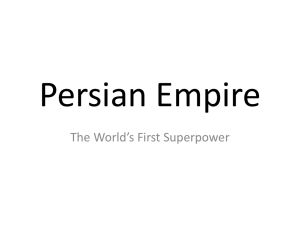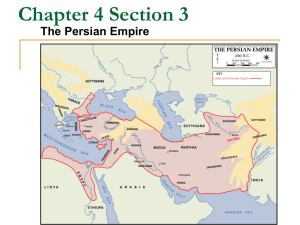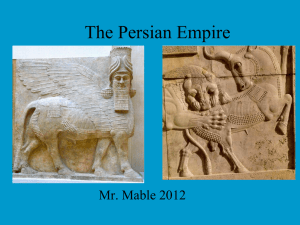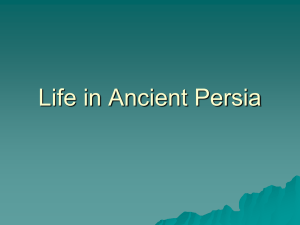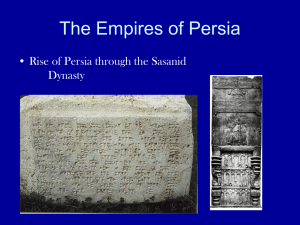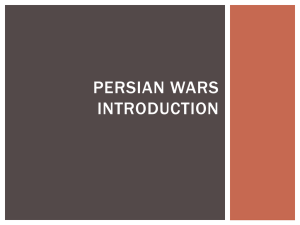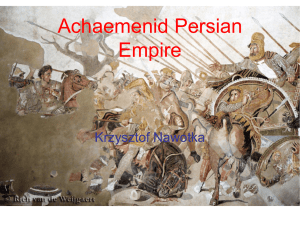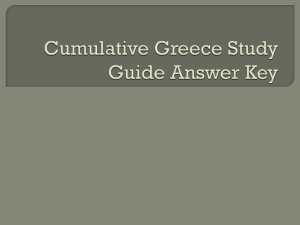Persian Empire
advertisement
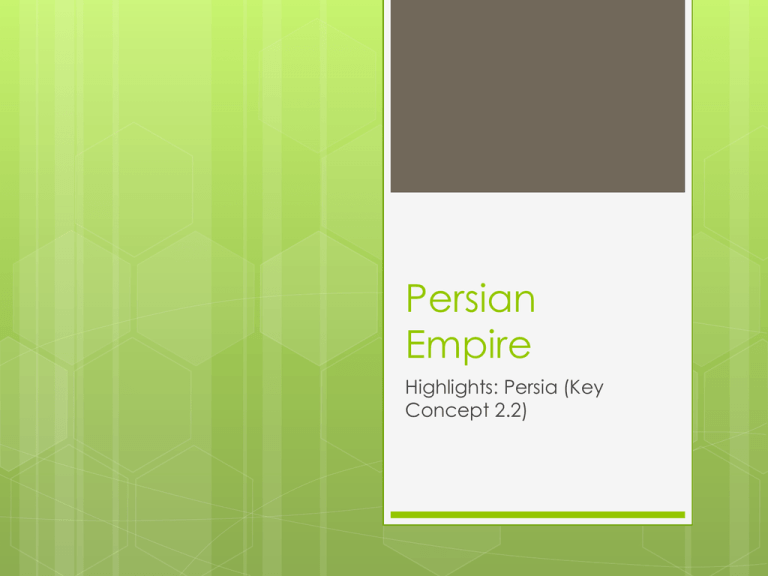
Persian Empire Highlights: Persia (Key Concept 2.2) Key Concept 2.2: Development of States and Empires Know about ONE of these Persian empires: Achaemenid Parthian Sassanid Why PERSIA? In 500 BCE largest and most impressive empire, 35 m. people from diverse backgrounds. Persia—in Period 2 (600 BCE- 600 CE) Persian Empire: 525 B.C.E. Persia—in Period 2 (600 BCE- 600 CE) Parthian Empire: (247 BCE – 224 CE) Persia—in Period 2 (600 BCE- 600 CE) Persian Empire: 600.C.E. Administrative Institutions allowed early empires to thrive Centralized governments Elaborate legal systems and bureaucracies For example, in Persia: o o o o o o Darius divided the Persian Empire into several provinces to make it easier to govern. He appointed a governor called a satrap to carry out his orders in each province and to collect taxes. He used a system of imperial spies “eyes and ears of king.” Darius also started use of a Royal Road that allowed messages, soldiers, and mail to be sent quickly across the empire. He promoted trade and business and established a law code. General policy of respect for non-Persian cultural traditions. Projection of Military Power Diplomacy Developing Supply lines Building Fortifications, walls and roads (Royal Road) Drawing new groups of military officers and soldiers from local populations or conquered peoples Creation of a professional army was necessary for both maintenance of the peace, and also to enforce the authority of the king in cases of rebellion and foreign threat. Land army and later a navy as well Imperial expansion and Human Rights When Cyrus invaded Babylonia, he treated the locals honorably –no massacres. Set free Jewish captives and gave back the stolen ornaments of the Temple of Jerusalem and money to rebuild that Temple. Cyrus issued a decree that guaranteed social and religious freedoms of the Babylonians -first ever declaration of human rights. A copy of this decree, known as the Cyrus Cylinder (6th c. BCE) Economics Promotion of trade Economic integration (roads and currencies) For ex. in Persia: Standardized currency/ coinage Predictable taxes Newly dug canal (linking Nile and Red Sea) Royal Road (1700 miles—1 week message from end to end through official courier service) Used also by merchant caravans Herodotus: “Neither snow, nor rain, nor heat, nor darkness of night, prevents them from accomplishing the task proposed to them with utmost speed.” (USPS motto later…) Persepolis elaborate imperial center Symbol of imperial authority and legitimacy Materials were from all parts of the empire Social Structure Royal family (palaces with extensive gardens) the priests the military officers the soldiers the scribes The Peasants (mud huts) Methods used to maintain empire Food production Crop Diffusion o o o Persian farmers grew wheat, barley, olives and wine. They raised cattle, goats and sheep. Hunting and fishing were also an important source of food. Rich Persians also enjoyed hunting wild animals. Crops from one region were introduced to another. Rice and flax were introduced into Mesopotamia. Sesame was introduced into Egypt. Rewards for elite loyalty Gender Structure Persian society was patriarchal Men held the dominant positions in government, commerce, the military, and the family. BUT the position of Persian women in this society was rich, varied, and important. Women owned property, often managed their own assets, could work and earn wages for themselves, and were capable of becoming economically independent. Much of this was swept away by Alexander’s conquest, in the guise of Greek “civilization,” and the remainder with the rise of Islam. Environmental impacts Digging of qanats Building roads Use of windmills by 7th c. CE for water and corn grinding Changes in Farming and Irrigation Techniques—Qanat @1000 BCE, Persians started constructing elaborate tunnel systems for extracting groundwater in the dry mountain basins of present-day Iran Qanat tunnels were hand-dug, just large enough to fit the person doing the digging. Along the length of a qanat, vertical shafts were sunk at intervals of 20 to 30 meters to remove excavated material and to provide ventilation and access for repairs The main qanat tunnel sloped gently down to an outlet at a village. From there, canals would distribute water to fields for irrigation. These amazing structures allowed Persian farmers to succeed despite long dry periods when there was no surface water to be had. Many qanats are still in use stretching from China on the east to Morocco on the west, and even to the Americas. Qanats Changes in Farming and Irrigation Techniques One possibility for the diffusion of qanat technology. “While the above diffusion model is nice and neat, human activities are rarely so orderly. Qanat technology may have been introduced into the central Sahara and later into western Sahara by Judaized Berbers fleeing Cyrenaica during Trajan's persecution in 118 AD. Since the systems in South America may predate the Spanish entry into the New World, their development may have occurred independently from any Persian influence. The Chinese, while acknowledging a possible Persian connection, find an antecedent to the qanats of Turpan in the Longshouqu Canal (constructed approximately 100 BC). The Romans used qanats in conjunction with aqueducts to serve urban water supply systems (a qanat-aqueduct system was built in Roman Lyons). A Roman qanat system was also constructed near Murcia in southeastern Spain. The Catalan qanat systems (also in Spain) do not seem to have been related to Islamic activity and are more likely later constructions, based on knowledge of Roman systems in southern France.” http://www.waterhistory.org/histories/qanats/ Trade Networks—Eurasian Silk Roads Parthians and Persians were intermediaries on the Silk Roads (silk and textiles) Legacy of Persia For next 1000 years, Persian imperial bureaucracy and court life, including administrators, tax collectors, record keepers, and translators, provided a role model for the entire region. Will Durant (American) in 1948: “For thousands of years Persians have been creating beauty. Sixteen centuries before Christ there went from these regions or near it... You have been here a kind of watershed of civilization, pouring your blood and thought and art and religion eastward and westward into the world... I need not rehearse for you again the achievements of your Achaemenid period. Then for the first time in known history an empire almost as extensive as the United States received an orderly government, a competence of administration, a web of swift communications, a security of movement by men and goods on majestic roads, equaled before our time only by the zenith of Imperial Rome.”

